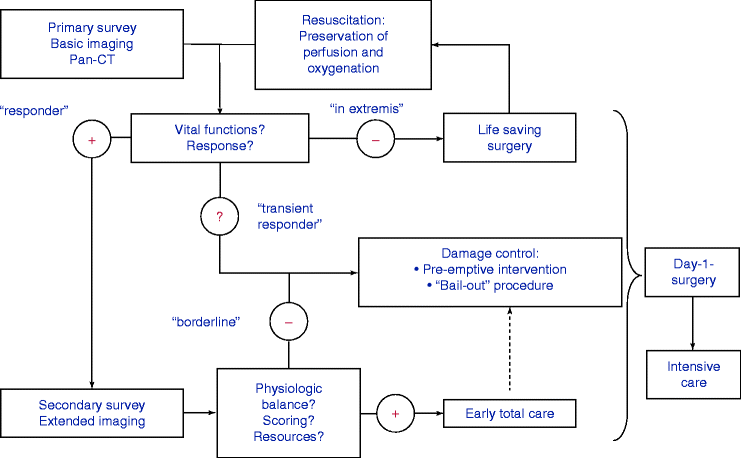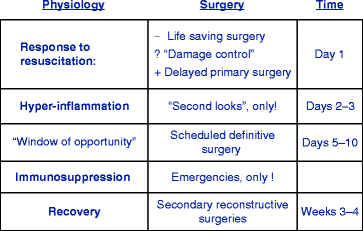Fig. 5.1
Traumatic and interventional antigenic load on the pulmonary endothelium and alveolar epithelium in severe trauma conditions
By releasing these substances, a cascade of local and systemic defense mechanisms is activated and immunocompetent cells are directed to control, débride, and repair the tissue defects.
Stress and pain are potent stimuli [1] for neuroendocrine, neuroimmunological, and metabolic responses. In addition, if hemorrhage, contamination, and ischemia-reperfusion injury complicate fractures, or if these are caused by associated injuries, systemic reactions to trauma produce a systemic inflammatory response syndrome (SIRS) [2]. SIRS is associated with a general capillary leak syndrome and high-energy consumption demanding a hyperdynamic hemodynamic state (flow phase) and an increased availability of oxygen. This flow phase generates an intense metabolic load with significant muscle wasting, nitrogen loss, and accelerated protein breakdown. This hypermetabolic state is accompanied by an increase in core body temperature and by thermal dysregulation.
If adequate and timely resuscitation is neither permitted (by the severity of trauma) nor provided (by the quality of care), the high-energy consumption will lead to “burn out”. This process moves from depletion of immunocompetent cells and acute-phase proteins to critical immunosuppression and sepsis, then onward via increased cell damage, to a multiple organ dysfunction syndrome (MODS), and ultimately lethal multiple organ failure [3–5].
5.4 Timing and Priorities of Surgery (Fig. 5.2)

Fig. 5.2
Algorithm for resuscitation, assessment, and acute surgery in polytrauma
The primary objective during initial care of polytraumatized patients is survival with normal cognitive function. The first priority is resuscitation to ensure adequate perfusion and oxygenation of all vital organs. This can usually be accomplished by conservative means such as intubation, ventilation, and volume replacement according to the Advanced Trauma Life Support (ATLS®) protocol. If the response to such measures is not successful, immediate life–saving surgery is necessary:
Decompression of body cavities (tension pneumothorax, cardiac tamponade, epidural hematoma);
Control of exsanguinating hemorrhage (massive hemothorax or hemoperitoneum, crushed pelvis; whole limb amputation, mangled extremity).
If there is poor response to resuscitation or ongoing physiological weakness in the patient, definitive surgery should be avoided and the concept of damage control applied. The rationale behind this concept is saving the life by deferring repair of anatomical lesions and focusing on restoring physiology [6–9].
Briefly stated, there are two different conditions for selecting damage–control surgery:
1.
Physiological criteria: hypothermia, coagulopathy, and acidosis; patient “in extremis”.
2.
Complex pattern of severe injuries: expecting major blood loss and prolonged reconstructive procedures in an unstable patient.
Damage control can be utilized in two ways:
1.
Reactively: “bail-out” surgery, which means aborted termination of procedures in a patient at imminent risk of death;
2.
Pre–emptively: calculated early decision to accomplish definitive repair in staged sequential procedures because of a high risk of physiological deterioration.
Damage control procedures such as control of hemorrhage, source control, irrigation, packing, external fixation of long bones and pelvic ring, and provisional closure of wounds or abdominal cavity are followed by stabilization of the physiological systems in the intensive care unit (ICU). After physiological restoration in the ICU, staged definitive surgery can take place under improved and safer conditions. With regard to fracture repair, there is a “window of opportunity” between day 5 and 10 post-trauma. Damage control surgery is indicated in about one third of polytrauma patients.
If there is a positive response to resuscitation and the patient remains stable during the “secondary survey”, then “early total care” can begin according to the general principles of fracture care.
Fracture fixation must have a high priority within the scope of this algorithm:
Limb-threatening and disabling injuries (including open fractures) require at least damage control: débridement, fasciotomies, reduction, stabilization, and revascularization [10].
Long bone fractures (especially femoral shaft fractures), unstable pelvic injuries, highly unstable large joints, and spinal injuries require at least provisional reduction and fixation. Definitive fixation may have to wait. A better option would be temporary stabilization by means of an external fixator followed by scheduled, definitive osteosynthesis (intramedullary nailing) during a window of opportunity between day 5 and 10 [10].
There is evidence, from clinical experience as well as in the literature, that early fracture fixation in polytrauma is beneficial in terms of mortality and morbidity [11–13].
The arguments and experience in favor of early fixation of femoral fractures and unstable pelvic-ring injuries are:
Reduction of the incidence of acute respiratory distress syndrome (ARDS), fat embolism and pneumonia, MODS, sepsis, and thromboembolic complications;
Facilitation of nursing and intensive care: Upright chest position, early mobilization, use of less analgesia.
Definitive osteosynthesis as day 1 surgery is advisable only when all the endpoints of resuscitation [14] have been accomplished.
Between the fifth and tenth day post-trauma an immunological window of opportunity exists, when the phase of hyperinflammation is followed by a period of immunosuppression and when new cell recruitment and de novo synthesis of acute-phase proteins are taking place.
During the “window of opportunity”, scheduled definitive surgery of long bone fractures (shaft and articular) can be performed relatively safely.
This period of immunosuppression lasts for about 2–3 weeks; therefore, secondary reconstructive procedures can be planned for the third or fourth week post-trauma (Fig. 5.3).


Fig. 5.3
Roadmap for timing of surgeries according to the physiological status of the patient
5.5 General Aims and Scopes of Fracture Management in Polytrauma
Fractures can have an important impact on the severity of systemic traumatic reactions as a result of
Hemorrhage: Prolonged states of shock as well as exsanguinating hemorrhage are frequently associated with open or highly unstable pelvic ring injuries or femoral shaft fractures.
Contamination: Open fractures must always be considered as contaminated. If a wound can only be débrided after some delay or if débridement is not radical enough, bacterial nutrients will develop in the wound. A second or even third débridement is therefore mandatory.
Dead, ischemic tissue with a marginally perfused hypoxic zone: In unstable, displaced fractures, particularly after high-energy impact, a radical soft-tissue débridement is necessary as soon as possible in order to control the source of the inflammatory reaction.
Ischemia–reperfusion injury: Prolonged hypovolemic shock and compartment syndromes related to fractures with or without vascular injuries are prone to ischemia-reperfusion injury with microvascular damage because of oxygen radicals. Blunt tissue contusions may activate xanthine oxidase; ischemia will produce the substrate xanthine/hypoxanthine, and reperfusion will add co-substrate oxygen. A dangerous triad is thus established.
Stress and pain: Unstable fractures cause pain and stress, which via afferent input [1] to the central nervous system, stimulate a neuroendocrine, neuroimmunological, and metabolic reflex arc.
Interference with intensive care: Unstable fractures prevent effective patient postures (upright chest) and pain-free handling in intensive care.
The general aims and scope of fracture management are:
Control of hemorrhage;
Control of sources of contamination, removal of dead tissue, prevention of ischemia-reperfusion injury;
Pain relief;
Facilitating intensive care.
These concepts can be realized by hemostasis, débridement, fasciotomy, fracture fixation, and tension-free wound coverage.
For stabilization of long bones, external and internal fixation as well as plates and nails are options depending on the circumstances.
5.6 Pros and Cons of Different Fixation Methods
Intramedullary nailing is, from the biomechanical point of view, the method of choice for shaft fractures of the femur and tibia. However, femoral nailing, reamed as well as unreamed, bears the risk of pulmonary embolization [15].
The main reason for this is the manipulation of the content of the medullary canal by opening, insertion of guide-wire, reaming, and placement of a nail. This increases the intramedullary pressure so that emboli of bone marrow content, fibrin clots, and debris are introduced into the pulmonary circulation. Embolization also causes activation of coagulation and other cascade systems.
The immense clearing capacity of the pulmonary endothelium may already be compromised by a lung contusion, a massive transfusion of allogenic blood, a spill over of cytokines and mediators from large wounds with dead tissues, or an incomplete resuscitation from shock. In this situation, the additional insult arising from iatrogenic embolization can crucially damage pulmonary function (Fig. 5.1). Furthermore, it is important to realize that simple fracture types (transverse and short oblique) in a young patient with a narrow medullary canal and well-developed muscle envelope are more prone to be followed by pulmonary embolization after intramedullary nailing than complex fractures with extensive fragmentation of the femoral shaft, or fractures in elderly individuals with poorer muscles and a wide medullary canal. Currently, there is no evidence that intramedullary nailing without reaming is less dangerous than intra-medullary nailing after reaming.

Full access? Get Clinical Tree








